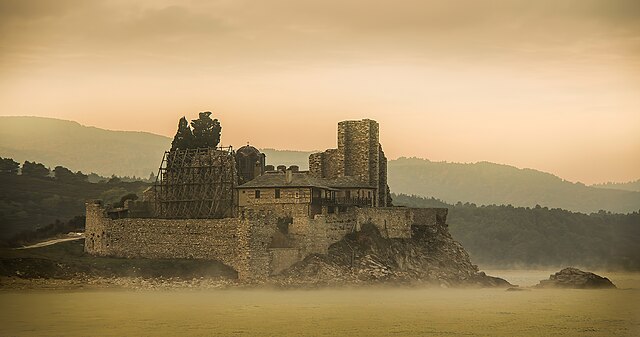
Monasteries of Mount Athos, Holy Place of the Orthodox Church
At the roots of the Orthodox Church: an ancient legend has Mary, the mother of Jesus Christ, and the disciple John traveling through the Greek islands until they have to end up in one place due to a severe storm
That beautiful place was the peninsula of Mount Athos and from that moment it would have been the garden of the Mother of God, exclusive to her and from which women and all female animals would always have remained outside.
This is still the case today for access to the twenty monasteries where Christian monks live, under the aegis of the Sacred Community, a government made up of twenty monks representing each of the monasteries and under the spiritual guidance of the Ecumenical Patriarchate of Constantinople.
With daily access to 120 males, of which only 10 are allowed to be foreigners, this peninsula of mountainous terrain is located in central Macedonia in northern Greece.
Under Greek sovereignty, it is an autonomous territory called the Autonomous Monastic State of the Sacro Monte which is allowed its own legislation, unrelated to Greek or European Union laws.
Orthodox Church on Mount Athos, more than a hundred monasteries
The sacredness of Mount Athos already comes from the Greeks for whom this enclave was the first abode of the god Zeus, which is why they called it “Agion Oros” (Sacred Mount).
The first Christian hermits arrived in this area around the 7th century and the first monasteries were built in the 10th century, following the preaching of the monk Saint Athanasius of Athos.
Willing to lead an ascetic life, he carried only two books with him.
Thanks to a large donation and the approval of Emperor Basil II for the construction of a temple in honor of the Mother of God after her victory over the Muslims, Athanasius built the first monastery, called Great Laura (the Slavic name lavra means “ monastery”). ”) under the dominion of San Basilio.
To this day, it remains the largest monastery on Mount Athos and the first in the hierarchy.
Saint Athanasius is also buried there.
An imperial edict granted the monks of Athanasius perpetual rights on Mount Athos, which led to the construction of new monasteries (up to more than a hundred), sketaes and hermitages over the centuries under the protection of the Byzantine Empire.
Latin profanations
During the Fourth Crusade (1202-1204), called mercantile or commercial, the kings and the papacy forgot the religious purpose of the reconquest of the Holy Places to concentrate on the financial aspects and to take advantage of the weakness of the Byzantine Empire by invading and founding the Latin Empire of Constantinople.
In this context, an army of Catalan-Aragonese mercenaries, called Almogavars, sacked and burned the monasteries of Mount Athos and impiously killed hundreds of monks.
Later the Latin invaders were driven out by the rise to power of Emperor Michael VIII, who revitalized the Byzantine Empire.
With the fall of Constantinople to the Ottomans in 1453, the Eastern Empire came to an end.
The payment of very high taxes was imposed on the abbeys of Mount Athos which, in addition to continuous harassment, produced a significant decline in the number of monks in the following centuries, which only flourished again in the nineteenth century with the donations and the power of the Slavic countries, mainly from the czars Russians.
Monasteries of the Orthodox Church, the current situation
Currently twenty large monasteries are active on Mount Athos, each governed by an abbot, who meets twice a year in the so-called Holy Assembly.
The life of the monks is still regulated by the “Tragos” of the year 907, which divides their daily life into three equal parts dedicated to prayer, work and rest, similar to the Catholic way.
The monastic day begins at four in the morning for Matins.
After the other activities, the main meal takes place and then the personal duties of each monk.
In the afternoon they still dedicate time to prayer.
We have dinner very early and rest until eleven in the evening, time for individual meditation.
Read Also
Gospel Of Sunday 07 May: John 14, 1-12
Gospel Of Sunday 23 April: Luke 24, 13-35
Gospel Of Sunday 16 April: John 20, 19-31
Gospel Of Sunday 09 April: John 20, 1-9
Gospel Of Sunday 02 April: Matthew 26, 14-27, 66
Gospel Of Sunday 26 March: John 11, 1-45
Easter 2023, It’s Time For Greetings To Spazio Spadoni: “For All Christians It Represents Rebirth”
Grand Imam Azhar Sheikh: We Appreciate Pope Francis’ Efforts To Promote Peace And Coexistence
Mission Lands, Pope Francis’ Horror At Violence In Northern Congo
War In Ukraine, European Bishops Call For Peace: COMECE Appeal
Saint Of The Day For November 7: Saint Vincenzo Grossi
Interreligious Dialogue: 7 Korean Religious Leaders To Meet Pope Francis
War In Ukraine, Prayers For Peace In Moscow, According To Pope’s Intentions
Africa, Bishop Fikremariam Hagos And Two Priests Arrested In Eritrea: The War In Tigray Continues
Assisi, The Full Speech Of Pope Francis To The Young People Of The Economy Of Francesco
